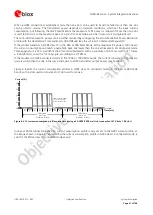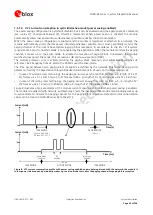
LARA-R2 series - System Integration Manual
UBX-16010573 - R02
Objective Specification
System description
Page 34 of 148
1.7.2
Antenna detection interface (ANT_DET)
The antenna detection is based on ADC measurement. The
ANT_DET
pin is an Analog to Digital Converter
(ADC) provided to sense the antenna presence.
The antenna detection function provided by
ANT_DET
pin is an optional feature that can be implemented if the
application requires it. The antenna detection is forced by the +UANTR AT command. See the
u-blox AT
Commands Manual
[2] for more details on this feature.
The
ANT_DET
pin generates a DC current (for detailed characteristics see the
LARA-R2 series
Data Sheet
[1]) and
measures the resulting DC voltage, thus determining the resistance from the antenna connector provided on the
application board to GND. So, the requirements to achieve antenna detection functionality are the following:
an RF antenna assembly with a built-in resistor (diagnostic circuit) must be used
an antenna detection circuit must be implemented on the application board
See section 2.4.2 for antenna detection circuit on application board and diagnostic circuit on antenna assembly
design-in guidelines.
1.8
SIM interface
1.8.1
SIM card interface
LARA-R2 series modules provide a high-speed SIM/ME interface, including automatic detection and
configuration of the voltage required by the connected SIM card or chip.
Both 1.8 V and 3 V SIM types are supported: activation and deactivation with automatic voltage switch from
1.8 V to 3 V is implemented, according to ISO-IEC 7816-3 specifications. The
VSIM
supply output pin provides
internal short circuit protection to limit start-up current and protect the device in short circuit situations.
The SIM driver supports the PPS (Protocol and Parameter Selection) procedure for baud-rate selection, according
to the values determined by the SIM Card.
1.8.2
SIM card detection interface (SIM_DET)
The
GPIO5
pin is by default configured to detect the external SIM card mechanical / physical presence. The pin is
configured as input, and it can sense SIM card presence as intended to be properly connected to the mechanical
switch of a SIM card holder as described in section 2.5:
Low logic level at
GPIO5
input pin is recognized as SIM card not present
High logic level at
GPIO5
input pin is recognized as SIM card present
The SIM card detection function provided by
GPIO5
pin is an optional feature that can be implemented / used or
not according to the application requirements: an Unsolicited Result Code (URC) is generated each time that
there is a change of status (for more details see
u-blox AT Commands Manual
[2], +UGPIOC, +CIND, +CMER).
The optional function “SIM card hot insertion/removal” can be additionally configured on the
GPIO5
pin by
specific AT command (see the
u-blox AT Commands Manual
[2], +UDCONF=50), in order to enable / disable the
SIM interface upon detection of external SIM card physical insertion / removal.
















































